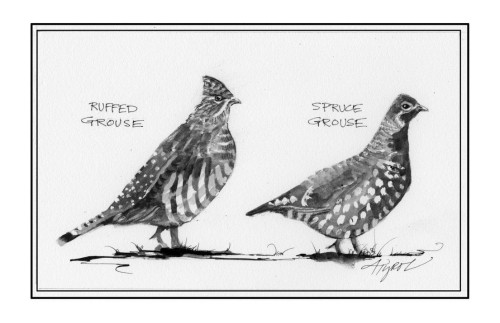
One of Vermont and New Hampshire’s least-known birds is the spruce grouse. This is partly because the birds live exclusively in the boreal forests of northeast Vermont and northern New Hampshire and partly because there’s just not a lot of spruce grouse out there. Land-use practices over the last 300 years have reduced the size and spread of the boreal forest and created unconnected islands of habitat that isolate spruce grouse populations from one another and from the vast boreal forest of Canada. The spruce grouse is currently on the endangered species list in Vermont and is a species of conservation concern in New Hampshire.
How can you distinguish a spruce grouse from the far more common ruffed grouse? Spruce grouse (Falcipennis canadensis) are heavy-bodied birds with short, rounded wings and a short beak. Males are slate-gray to black with bold white spots on the breast and a distinctive red comb. Females look more like ruffed grouse (Bonasa umbellus) but are slightly smaller and darker in color, and lack the ruffed grouses’ crown feathers and large tail fan. Spruce grouse have feathers that extend to the base of their toes, which is an adaptation for walking on snow and is another key feature that distinguishes them from ruffed grouse.
The distinction between the two species is critical for hunters: ruffed grouse are a common game species while spruce grouse cannot legally be hunted in either state.
The most likely place to spot a spruce grouse is in a spruce-fir forest where the trees are between 20 and 50 years of age. This is when the forest has the greatest amount of vertical stratification and variety of branches and perches. Spruce is preferred over fir because it develops and maintains better vertical stratification. Habitat becomes less suitable where tree height is greater than 50 feet and the live crown is less than 50 percent of the total height of the tree. Research from Maine suggests spruce grouse generally select trees that are 25 to 30 feet tall.
Spruce grouse also prefer an understory of low to moderate density, especially where wild blueberries and other plants in the heath family are found. A shrub layer that’s too dense will likely preclude movement and, perhaps more importantly, reduce the grouse’s ability to detect predators.
Spruce grouse usually start breeding at one year of age. Males occupy breeding territories in the spring and begin their courtship display, which consists of “flutter flights” between low perches and the ground and strutting about with red eye combs inflated and tail feathers fanned. Females select a nest site outside of the male’s territory. The nest is a rounded depression in the substrate lined with dead conifer needles, leaves and feathers and is usually located under branches or thickets. Egg laying begins approximately 17 days after the ground becomes 50 percent snow-free. Females deposit a clutch averaging 5.6 eggs, and incubation averages 21-23 days. Broods leave the nest within one day of hatching.
The present Vermont breeding spruce grouse population, estimated to be about 100 birds, is limited to the 24-square-mile Nulhegan Basin between the Wenlock Wildlife Management Area in Ferdinand and the so-called “Yellow Bogs” area in Lewis. The Nulhegan Basin provides habitat for the spruce grouse with stands of pure black spruce or mixed spruce, balsam fir, and larch dominating the vegetative cover of these lowland boreal forests. Scattered alder swamps and small open bogs are also present.
In New Hampshire, with its greater expanse of boreal forest, breeding populations of spruce grouse occur in parts of the White Mountain National Forest and Coos County. The objective of the state’s wildlife action plan is to increase the amount of suitable habitat – especially lowland boreal forest – so that existing breeding populations will be able to expand their range.
In Vermont, where the breeding population is so much smaller, the Fish and Wildlife Department is working to increase spruce grouse populations to the point that the birds will no longer be considered endangered. Vermont wildlife staff, with assistance from the State of Maine and Province of Quebec, trapped and relocated 134 spruce grouse (males, females, and chicks) to the Victory Basin Wildlife Management area. In this part of Vermont, there are a number of landowners with large contiguous forest holdings, including the State and the U.S. Fish and Wildlife Service. Post-release monitoring by Department personnel will provide information as to how well the relocated birds have fared.
It will likely be 10-15 years before the outcome of the effort in Vermont is realized, but all of the components are in place for the spruce grouse to make a comeback.

